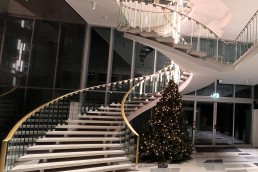
Ambient Communication: Part two
In the second of a two-part series on the subject, Tapio Rosenius demonstrates how Ambient Communication strategies can lead to a tangible change in human behaviour and architectural interaction.
Ambient Communication is a novel approach to influencing human behavior through light. Our goal is to revolutionize how architectural spaces are strategically optimized to impact human decision-making processes. We aim to demonstrate the influence of connected and real-time lighting as a new tool for lighting designers, bringing added value to building owners, operators, and users.
In the first part of this two-part article, we introduced the concept and its application in lighting design (see arc #136). In this second part, we will describe a new research framework developed specifically to deploy and validate the concept in real-world settings.
For the development of this new research framework, Skandal Technologies, a technology startup, and the developer of the Poet Creator Software, joined forces with The Center for Behavioral Decisions. This established research and consulting firm specialises in the application of behavioral science, combining behavioral insights with strategic lighting innovations.
Introduction
The interplay between human behavior and the surrounding environment has been a focal point for researchers, architects, and designers. At the core of this exploration lies the concept of behavioral interventions – strategies or treatments introduced to groups or individuals to change certain behaviors.
Ambient communication refers to the subtle cues that an environment provides, influencing behavior through gentle nudges rather than direct instructions. Given our continuous interaction with the environment, the potential of ambient communication as an intervention mechanism is immense and untapped.
Within ambient communication, lighting emerges as a significant and potent medium. The omnipresence of lighting in our daily lives underscores its potential as a powerful tool for behavioral influence. Through nuances in intensity, colour, and pattern, lighting can shape decisions, encourage actions, or evoke specific emotions.
By merging insights from behavioral science with the art and science of lighting design, we embark on a journey to redefine spaces and positively influence the choices and behaviors of occupants.
Our Goal
Primary Goal: Utilise lighting as a dynamic tool to encourage healthier decisions, such as staircase use, and enhance workplace productivity.
Secondary Goal: Adapt lighting ambiance to specific tasks, events, and situational needs, fortifying an environment that continuously boosts human performance.
Unique Approach: Employ an adaptive method to fine-tune interventions, setting a novel standard in integrating behavioral insights with ambient cues.
Introducing JITAABI
The adaptive approach, exemplified by Just-In-Time Adaptive Ambient Behavioural Interventions (JITAABI), marks a groundbreaking shift in behavioral interventions. JITAABI is a nuanced adaptation of the Just-In-Time Adaptive Intervention, tailored specifically for ambient communication through lighting.
Significance and Benefits Over Traditional Methods:
Traditional behavioral interventions often assume static human behavior, employing a generalised strategy. In contrast, the adaptive method, particularly JITAABI, recognises and adapts to the dynamic nature of human behavior. JITAABI undergoes numerous trials, utilising momentary passive-assessed data from embedded sensors to determine the most opportune intervention – both in terms of timing and type. This process ensures greater efficacy and minimises counterproductive actions.
Ability to Identify the Best Intervention:
JITAABI integrates several components like tailoring variables, decision points, and a range of intervention options. Through continuous evaluation and real-time feedback from embedded sensors, JITAABI refines its strategies, swiftly identifying and implementing the best interventions. This iterative process, backed by real-time sensor data and realised by the Poet Creator real-time content and control system crafts environments that adaptively and positively influence individual behaviors, seamlessly marrying ambient communication through lighting with behavioral science insights.
In essence, the adaptive approach of JITAABI offers a pioneering roadmap for the future, delivering precise, effective, and timely interventions. Through this innovative methodology, it heralds a transformative era in environmental design, seamlessly integrating behavioral science.
Early Findings
A dynamic pixel-controlled luminaire was suspended in an existing spiral staircase for an office building refurbishment project in Zurich, Switzerland. The lighting, controlled by the Poet system and treated as an ambient communication intervention, was tested using the JITAABI research framework to explore its influence on building users’ choice architecture and stair usage.
Specialized 3D AI sensors were installed at each floor level to record stair use, with separate data collected for each flight of steps in both up and down directions. The data was fed live to the control system that in turn generated real-time visual content controlling the fixture. A six-month control period with the luminaire in a static white setting provided a baseline of stair usage.
Observed Benefits
For a controlled period of six weeks, the lighting setting was changed to generative upwards light movement, resulting in a 6% increase in stair usage. A second 12-week period with interactive lighting behaviors, where white light patterns responded to people on the stairs, led to an additional 8% increase compared to the baseline.
Dynamic & Interactive lighting increased stair usage by: 14%
From research literature, we know that:
• A single step up burns approximately 0.17 calories.
•A single step up extends life by approximately four seconds.
We can also observe that each time the stair is used, an elevator trip is saved.
During the six-month period of dynamic and interactive lighting control with real-time data collection, we deduced:
• 78,342 extra calories burned by building occupants
• 21 days of life extended
• 11,549 elevator trips saved
Conclusion
This pioneering study underscores the transformative power of combining behavioral science with strategic lighting design. The innovative JITAABI mechanism highlights the immense potential of adaptive ambient communication through lighting to influence human behavior in real-time. The future beckons a new era where the subtle cues from our surroundings play a pivotal role in shaping our decisions and actions. This adaptive approach positions lighting not just as a medium of illumination but as a dynamic tool for efficient behavioral intervention and enhanced environmental design.
www.poet.software
www.becisions.com



